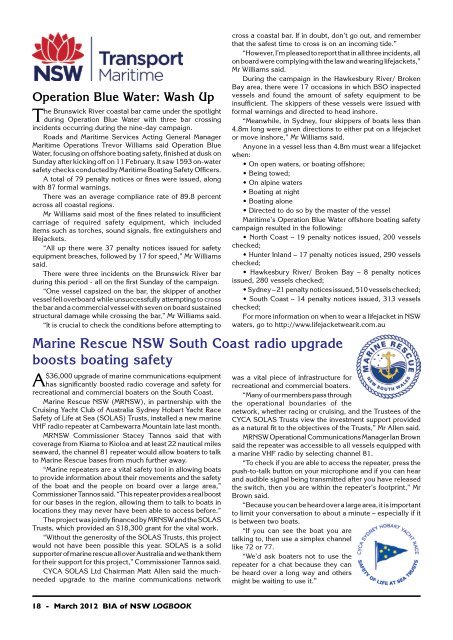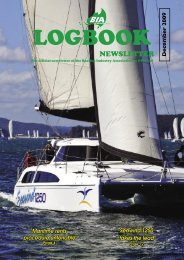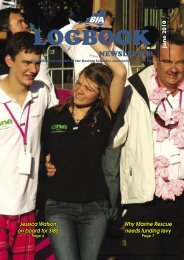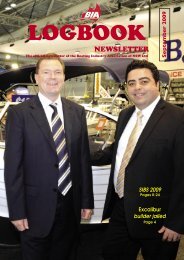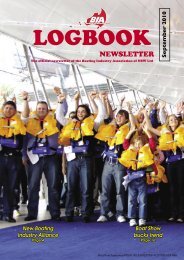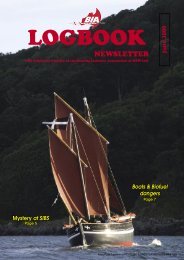March 2012 - Boating Industry Association of NSW
March 2012 - Boating Industry Association of NSW
March 2012 - Boating Industry Association of NSW
Create successful ePaper yourself
Turn your PDF publications into a flip-book with our unique Google optimized e-Paper software.
Operation Blue Water: Wash Up<br />
The Brunswick River coastal bar came under the spotlight<br />
during Operation Blue Water with three bar crossing<br />
incidents occurring during the nine-day campaign.<br />
Roads and Maritime Services Acting General Manager<br />
Maritime Operations Trevor Williams said Operation Blue<br />
Water, focusing on <strong>of</strong>fshore boating safety, finished at dusk on<br />
Sunday after kicking <strong>of</strong>f on 11 February. It saw 1593 on-water<br />
safety checks conducted by Maritime <strong>Boating</strong> Safety Officers.<br />
A total <strong>of</strong> 79 penalty notices or fines were issued, along<br />
with 87 formal warnings.<br />
There was an average compliance rate <strong>of</strong> 89.8 percent<br />
across all coastal regions.<br />
Mr Williams said most <strong>of</strong> the fines related to insufficient<br />
carriage <strong>of</strong> required safety equipment, which included<br />
items such as torches, sound signals, fire extinguishers and<br />
lifejackets.<br />
“All up there were 37 penalty notices issued for safety<br />
equipment breaches, followed by 17 for speed,” Mr Williams<br />
said.<br />
There were three incidents on the Brunswick River bar<br />
during this period - all on the first Sunday <strong>of</strong> the campaign.<br />
“One vessel capsized on the bar, the skipper <strong>of</strong> another<br />
vessel fell overboard while unsuccessfully attempting to cross<br />
the bar and a commercial vessel with seven on board sustained<br />
structural damage while crossing the bar,” Mr Williams said.<br />
“It is crucial to check the conditions before attempting to<br />
$36,000 upgrade <strong>of</strong> marine communications equipment<br />
A has significantly boosted radio coverage and safety for<br />
recreational and commercial boaters on the South Coast.<br />
Marine Rescue <strong>NSW</strong> (MR<strong>NSW</strong>), in partnership with the<br />
Cruising Yacht Club <strong>of</strong> Australia Sydney Hobart Yacht Race<br />
Safety <strong>of</strong> Life at Sea (SOLAS) Trusts, installed a new marine<br />
VHF radio repeater at Cambewarra Mountain late last month.<br />
MR<strong>NSW</strong> Commissioner Stacey Tannos said that with<br />
coverage from Kiama to Kioloa and at least 22 nautical miles<br />
seaward, the channel 81 repeater would allow boaters to talk<br />
to Marine Rescue bases from much further away.<br />
“Marine repeaters are a vital safety tool in allowing boats<br />
to provide information about their movements and the safety<br />
<strong>of</strong> the boat and the people on board over a large area,”<br />
Commissioner Tannos said. “This repeater provides a real boost<br />
for our bases in the region, allowing them to talk to boats in<br />
locations they may never have been able to access before.”<br />
The project was jointly financed by MR<strong>NSW</strong> and the SOLAS<br />
Trusts, which provided an $18,300 grant for the vital work.<br />
“Without the generosity <strong>of</strong> the SOLAS Trusts, this project<br />
would not have been possible this year. SOLAS is a solid<br />
supporter <strong>of</strong> marine rescue all over Australia and we thank them<br />
for their support for this project,” Commissioner Tannos said.<br />
CYCA SOLAS Ltd Chairman Matt Allen said the muchneeded<br />
upgrade to the marine communications network<br />
cross a coastal bar. If in doubt, don’t go out, and remember<br />
that the safest time to cross is on an incoming tide.”<br />
“However, I’m pleased to report that in all three incidents, all<br />
on board were complying with the law and wearing lifejackets,”<br />
Mr Williams said.<br />
During the campaign in the Hawkesbury River/ Broken<br />
Bay area, there were 17 occasions in which BSO inspected<br />
vessels and found the amount <strong>of</strong> safety equipment to be<br />
insufficient. The skippers <strong>of</strong> these vessels were issued with<br />
formal warnings and directed to head inshore.<br />
“Meanwhile, in Sydney, four skippers <strong>of</strong> boats less than<br />
4.8m long were given directions to either put on a lifejacket<br />
or move inshore,” Mr Williams said.<br />
Anyone in a vessel less than 4.8m must wear a lifejacket<br />
when:<br />
• On open waters, or boating <strong>of</strong>fshore;<br />
• Being towed;<br />
• On alpine waters<br />
• <strong>Boating</strong> at night<br />
• <strong>Boating</strong> alone<br />
• Directed to do so by the master <strong>of</strong> the vessel<br />
Maritime’s Operation Blue Water <strong>of</strong>fshore boating safety<br />
campaign resulted in the following:<br />
• North Coast – 19 penalty notices issued, 200 vessels<br />
checked;<br />
• Hunter Inland – 17 penalty notices issued, 290 vessels<br />
checked;<br />
• Hawkesbury River/ Broken Bay – 8 penalty notices<br />
issued, 280 vessels checked;<br />
• Sydney – 21 penalty notices issued, 510 vessels checked;<br />
• South Coast – 14 penalty notices issued, 313 vessels<br />
checked;<br />
For more information on when to wear a lifejacket in <strong>NSW</strong><br />
waters, go to http://www.lifejacketwearit.com.au<br />
Marine Rescue <strong>NSW</strong> South Coast radio upgrade<br />
boosts boating safety<br />
was a vital piece <strong>of</strong> infrastructure for<br />
recreational and commercial boaters.<br />
“Many <strong>of</strong> our members pass through<br />
the operational boundaries <strong>of</strong> the<br />
network, whether racing or cruising, and the Trustees <strong>of</strong> the<br />
CYCA SOLAS Trusts view the investment support provided<br />
as a natural fit to the objectives <strong>of</strong> the Trusts,” Mr Allen said.<br />
MR<strong>NSW</strong> Operational Communications Manager Ian Brown<br />
said the repeater was accessible to all vessels equipped with<br />
a marine VHF radio by selecting channel 81.<br />
“To check if you are able to access the repeater, press the<br />
push-to-talk button on your microphone and if you can hear<br />
and audible signal being transmitted after you have released<br />
the switch, then you are within the repeater’s footprint,” Mr<br />
Brown said.<br />
“Because you can be heard over a large area, it is important<br />
to limit your conversation to about a minute – especially if it<br />
is between two boats.<br />
“If you can see the boat you are<br />
talking to, then use a simplex channel<br />
like 72 or 77.<br />
“We’d ask boaters not to use the<br />
repeater for a chat because they can<br />
be heard over a long way and others<br />
might be waiting to use it.”<br />
18 - <strong>March</strong> <strong>2012</strong> BIA <strong>of</strong> <strong>NSW</strong> LOGBOOK


